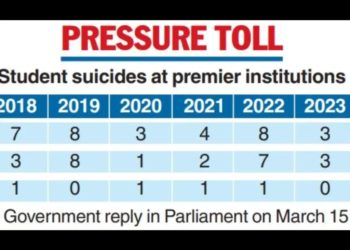October 8 marks the death anniversary of the civil rights activist K Balagopal. It is eight years since he died yet his writings are prescient for what they tell us about our social and political realities. Indeed, today it appears important to reference his classic essays on fascism in India – Rise of Gangsterism in Politics, written in February 1989, and Why Did December 6, 1992 happen?, written in April 1993.
Rather than take us through the ideas of European fascism, Balagopal calls attention to historical detail, to what makes fascism a political option in India.
He reminds us, in his 1989 article, that fascism is both reactive and proactive: it is a response to a ruling class that cannot get its act together and has to settle its contradictions through violence on the street. In the 1980s, at the dawn of the neoliberal era, when bureaucratic capital had to battle an indignant class of capitalists and heed the World Bank and the International Monetary Fund, the ruling class “resolved” the crisis in its ranks through political gangsterism. Thus, hoodlums turned legislators, acting as hatchet men for their ruling class bosses.
What was the state’s response? Unable to stretch its welfarism because it could not yield even minimal benefits given continual uneven economic growth, and faced with a restive population, the state affirmed its sovereignty through negative means. Balagopal reminds us that in the 1980s, these laws were proclaimed:
- three amendments to the National Security Act;
- extension of the Suppression of Disturbances Act and the Armed Forces (Special Powers) Act to Punjab;
- the Terrorist Affected Areas (Special Courts) Act;
- the Terrorist and Disruptive Activities (Prevention) Act;
- the Trade Unions and Industrial Disputes (Amendment) Bill;
- the Hospitals and Other Institutions (Redressal of Grievances) Bill;
- the Defamation Bill; the Postal Bill.
This period also witnessed the murder of dissenters such as the playwright Safdar Hashmi and the journalist Umesh Dhobal.
If we extend Balagopal’s reasoning it becomes evident that in today’s context political gangsterism is expressed not only through acts of crude violence – as, for instance, in the 1980s Andhra Pradesh – but also via unprincipled and cynical political dissembling – as in contemporary Tamil Nadu – and achieves much the same ends as political violence: subversion of democracy in a state, frozen into an economic and democratic impasse if not crisis. At the national level, we find something different at work: in addition to vigilante killings, there has been an upscaling of gangsterism, in that today’s gangsters are technically advanced, educated lumpens, internet trolls who pour hate into our inboxes as they attempt to counter dissent and critique of the ruling classes and their political leaders and ideologues.
‘Legal subversion of democracy’
As for the state, it continues to enact legislation that secures legal defence for the indefensible such as the laws against cow slaughter. But law and policy are also being put to use through other means. For one, those who follow the ruling party’s dictates rework procedural rules to secure their authority, such as we see happening in academic institutions and the financial sector. Of particular concern in this context are decisions to do with the economy, which are justified in the name of the national good, efficiency and as attempts to get a “moral” grip on a corrupt economy. It is clear that such decisions are unlikely to benefit anyone except those who can use the rule of law to get away with what can only be described as savage primitive accumulation (such as we see in Chhattisgarh, Odisha and Jharkhand), dispossession of worker rights (across the country), and the garnering of surplus through speculation, particularly in real estate (also a nation-wide phenomenon).
Such “legal” means of subverting democracy, Balagopal observed, serve an important purpose, especially where the masses have consistently fought for legal rights. He writes:
“The rights have got formal recognition in the law only because they have real recognition in the hearts of the masses, and therefore to rule the masses without recognising the rights would be impossible. And equally, when it becomes necessary to violate the rights, it is preferable to enact the violation as formal laws, so that the legitimacy that attaches to law as such will give whatever justification that is possible for the violation.”
In today’s context, the state does not appear to be worried about how people view the legality of its enactments, rather it uses the fact of legality to enable non-legal acts, such as we witnessed in Dadri, Uttar Pradesh, and Una, Gujarat. The point is, Balagopal notes in his 1993 essay, that the impunity that fascism reveals it has to be understood not only in political terms, but in social terms as well. The idea that fascism is but a tethering of popular and legitimate anger and frustration to ignorable ends that may explain what happened in Germany and Italy, but not what Hindutva does. Hitler and Mussolini did invoke socialism, for whatever dubious purpose, but “Hindutva abhors anything carrying the slightest taint of democracy and socialism so much that it will not even be populist.” Balagopal writes:
“A populist fascism, for instance, would today have made a big show of opposing the new economic policy. The BJP will not only not do that, it offers the most brazen arguments in defence of liberalisation of the economy. It must be remembered that the only time Hindutva so much as toyed with the idea of social equality was when the BJP adopted the ambiguous notion of Gandhian socialism for a short while, but that too was dropped very fast, for even the play-acting could not be stomached.”
‘Politics of resentment’
Such support for capitalist-driven “growth and development”, as we witness today, utilises long-standing homegrown rhetoric to underscore its appeal. As Balagopal reminds us, the core of Hindutva has to do with its commitment to the dharmic life, where each is to stay satisfied with their caste position in the social hierarchy and transfer whatever passion they have for upliftment to the service of the nation. So, what we have in the Indian context “is not a fascist distortion of positive aspirations, but a fascist concentration of negative traits, of resentment and frustration born in reaction to the space conquered by the oppressed and the underprivileged in India’s political universe.”
This politics of resentment is, of course, best expressed in the Sangh Parivar’s diatribe against ostensible state “pampering” of the minorities, but it draws its powers of persuasion from a society that thrives on “graded inequality”. As Balagopal argues:
“It is not often enough recognised in Marxist analysis of counterrevolution that privileges exist at all levels of society and not just at the top – though not all of them may have an equally determining influence on the social structure – and therefore there is a little enemy of equality within each one of us, however lowly we may be in relation to the totality. The smallest farmer thinks he is superior to the wage labourer – especially, though not only, if the latter is untouchable – and the lowliest man thinks he is lord of his wife.”
In fact, in this scheme of things, “the very recognition of rights that go against (especially but not exclusively) traditional hierarchies and forms of privilege is regarded as proof of ‘pampering’ by the privileged, a grouse that finds articulate expression the moment a climate of legitimacy is created, as for instance when the country is caught in a deep economic crisis.”
In today’s context, the expression of resentment has become formalised; acts of violence against those who are resented are allowed with the ruling dispensation’s silent approval. Attempts to redress this huge moral deficit through heart-to-heart talks with the nation – where banal beliefs about growth and progress are routinely mouthed – represent another sort of formalism, at once cynical and deadening. But then what can we expect from a framework “that cannot express any liberating ideal, but can sanctify every suppressive injunction, everything that is negative and inhuman”.
The only option left then is to continuously build a politics of hope, and the onus is on democratic forces. Such forces, Balagopal somberly observes, “have the task of devising a strategy that will defeat the seemingly natural process by which one underprivileged group sees another slightly more or less underprivileged as its enemy. They can neither be dismissive of the need to fight for equality and justice at all levels, nor of the need to create a real unity of the oppressed”.





